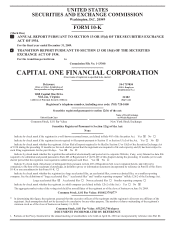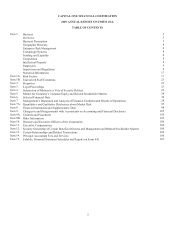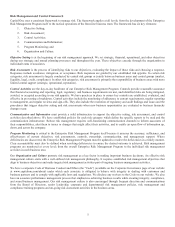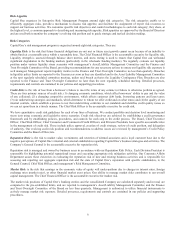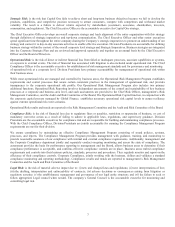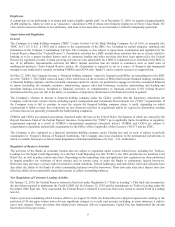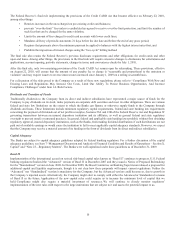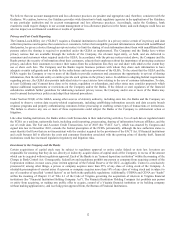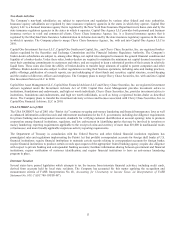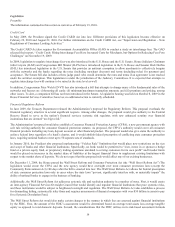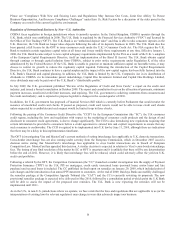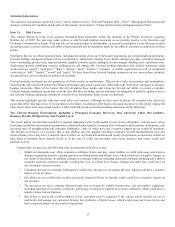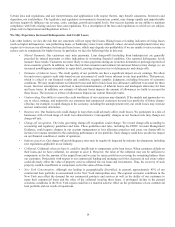Capital One 2009 Annual Report Download - page 23
Download and view the complete annual report
Please find page 23 of the 2009 Capital One annual report below. You can navigate through the pages in the report by either clicking on the pages listed below, or by using the keyword search tool below to find specific information within the annual report. 10
The Federal Reserve’s final rule implementing the provisions of the Credit CARD Act that became effective on February 22, 2010,
among other things:
• Restricts increases in the rates charged on pre-existing credit card balances;
• prevents “over-the-limit” fees unless a cardholder has agreed to receive over-the-limit protection, and limit the number of
such fees that can be charged for the same violation;
• Limits the amount of fees charged to credit card accounts with lower credit lines;
• Mandates delivery of periodic statements 21 days before the due date and before the end of any grace period;
• Requires that payments above the minimum payment be applied to balances with the highest interest rates first; and
• Prohibits the imposition of interest charges using the “two-cycle” billing method.
The final rule also retains the Federal Reserve’s previous disclosure requirements and other obligations for credit cards and other
open-end loans. Among other things, the provisions in the final rule will require extensive changes to disclosures for solicitations and
applications, account opening, periodic statements, changes in terms, and convenience checks by July 1, 2010.
After this final rule, only two remaining provisions of the Credit CARD Act remain open for rulemaking. These provisions, effective
on August 22, 2010, will ensure that the amount of any penalty fee or charge is “reasonable and proportional to the omission or
violation” and may require issuers to reverse interest rates increased since January 1, 2009 on a rolling six-month basis.
For a discussion of the risks posed to the Company as a result of these new regulations, please refer to “Compliance With New and
Existing Laws and Regulations May Increase Our Costs, Limit Our Ability To Pursue Business Opportunities, And Increase
Compliance Challenges” under Item 1A. Risk Factors.
Dividends and Transfers of Funds
Traditionally dividends to the Company from its direct and indirect subsidiaries have represented a major source of funds for the
Company to pay dividends on its stock, make payments on corporate debt securities and meet its other obligations. There are various
federal and state law limitations on the extent to which the Banks can finance or otherwise supply funds to the Company through
dividends and loans. These limitations include minimum regulatory capital requirements, federal and state banking law requirements
concerning the payment of dividends out of net profits or surplus, Sections 23A and 23B of the Federal Reserve Act and Regulation W
governing transactions between an insured depository institution and its affiliates, as well as general federal and state regulatory
oversight to prevent unsafe or unsound practices. In general, federal and applicable state banking laws prohibit, without first obtaining
regulatory approval, insured depository institutions, such as the Banks, from making dividend distributions if such distributions are not
paid out of available earnings or would cause the institution to fail to meet applicable capital adequacy standards. However, we expect
that the Company may receive a material amount of its funding in the form of dividends from its direct and indirect subsidiaries.
Capital Adequacy
The Banks are subject to capital adequacy guidelines adopted by federal banking regulators. For a further discussion of the capital
adequacy guidelines, see Item 7 “Management Discussion and Analysis of Financial Condition and Results of Operations – Section X.
Capital” and “Note 23—Regulatory Matters”. The Banks were well capitalized under these guidelines as of December 31, 2009.
Basel II
Implementation of the international accord on revised risk-based capital rules known as “Basel II” continues to progress. U.S. Federal
banking regulators finalized the “Advanced” version of Basel II in December 2007 and they issued a Notice of Proposed Rulemaking
for the “Standardized” version in June 2008. In December 2009, the Basel Committee on Banking Supervision released a proposal for
additional capital and liquidity requirements, though it is not clear how these proposals will impact current regulations. Neither the
“Advanced” nor “Standardized” version is mandatory for the Company, but the Advanced version could become so, due to growth in
the Company’s reported assets. Alternatively, the Company might elect to comply with either the Advanced or Standardized versions
of Basel II in the future. Application of the new capital rules could require us to increase the minimum level of capital that we
hold. Compliance might also require a material investment of resources. We will continue to closely monitor regulators’
implementation of the new rules with respect to the large institutions that are subject to it and assess the potential impact to us.



